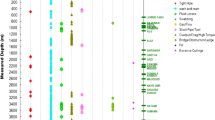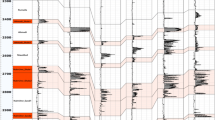Abstract
The most important factors in multi-lateral well stability analysis are the magnitude of in situ stresses, the relation between the amount of in situ stresses and orientation of lateral wellbore. In this research, the stability analysis of multi-lateral junction is carried out using FLAC3D numerical code by considering seven varied stress regimes and different lateral wellbore orientations. The Normalized Yielded Zone Area (NYZA, ratio of surrounding yielded cross-sectional area to initial area of well) is determined for different junction mud pressures as well as diverse orientations of lateral wellbore. Then, the junction optimum mud pressure of each lateral wellbore orientation is calculated; hence, the optimum trajectory of lateral wellbore, in which the junction has got the lowest optimum mud pressure, is selected in each stress regime. The stability analysis of multi-lateral wells by means of finite difference method shows that in each stress regime the required mud pressure for the stability of junction is much more than that of the lateral branch and the main wellbore.

















Similar content being viewed by others
References
Al-Ajmi A (2006) Wellbore stability analysis based on a new true-triaxial failure criterion. PhD. dissertation, Sultan Qaboos University, Muscat
FLAC3D (2006) Student license. Itasca Consul Group, Inc., USA
Garrouch AA, Lababidi HMS, Ebrahim AS (2004) An integrated approach for the planning and completion of horizontal and multilateral wells. J Pet Sci Eng 44:283–301
Jordan M, Paez R, Umudoro K (2002) New aspects of multilateral well construction. Oilfield Rev 14(3):52–69
McLellan PJ, Hawkes CD (2002) Coupled modeling of borehole instability and multiphase flow for underbalanced drilling. Adv Geotechnol Inc. IADC/SPE
Soliman MY, Boonen P (2000) Rock mechanics and stimulation aspects of horizontal wells. J Pet Sci Eng 25:187–204
Zhang J, Bai M, Roegiers JC (2006) On drilling directions for optimizing horizontal well stability using a dual-porosity poroelastic approach. J Pet Sci Eng 53:61–76
Author information
Authors and Affiliations
Corresponding author
Rights and permissions
About this article
Cite this article
Goshtasbi, K., Elyasi, A. & Naeimipour, A. 3D numerical stability analysis of multi-lateral well junctions. Arab J Geosci 6, 2981–2989 (2013). https://doi.org/10.1007/s12517-012-0558-x
Received:
Accepted:
Published:
Issue Date:
DOI: https://doi.org/10.1007/s12517-012-0558-x




